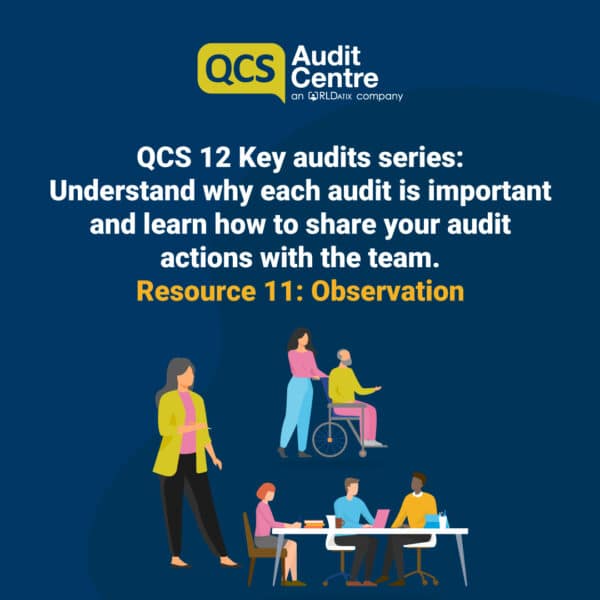Why do we need to complete audits?
To achieve good governance in your service you must demonstrate continuous quality improvement. To do this, auditing and documenting the effectiveness of the processes and systems you have in place, and taking the time to observe and document how people experience your service, is essential.
Audits and completed action plans offer evidence of the great care you provide. Where improvements are needed, they allow you to demonstrate openly and clearly how you plan to make the changes required that you have identified.
Observation: the case for auditing
The auditing of care practice by direct observation is a very important method to provide assurance that the quality of the care and support being provided is of high quality, person-centred, compassionate, respectful and promotes independence.
An observation audit is very different from other audits, as it does not rely on reviewing documentation or discussing processes with staff. It is an audit based on watching staff at work, performing their duties, and assessing the quality of their interactions with people using the service or others.
It is one of the few audits that are completed ‘in the moment’ and are immediate in their assessment of the evidence. This assessment is very important in understanding how the culture and vision for the service are translated into actions, and how well staff are embodying person-centred care.
Observation audits are also going to become more important over time, as the regulator is potentially going to be visiting services less frequently and will be relying more heavily on evidence provided by the service, or other stakeholders. As such, an observation audit, as long as it is honest and truthful, will be highly valuable as source of evidence.
An observation audit can also be used as an effective tool to identify poor practice, additional training needs and to reaffirm when exceptional care is given.
The observation audit is structured in its format and looks at the same areas each time it is completed. As such the audit can be used to benchmark the quality of care provided and is an excellent way of showing improvement over time.
It is also an objective way of identifying training needs, and encouraging staff to undertake additional training, or to seek more support to improve their practice. Conversely it can also be used as a way of highlighting exceptional care, and encouraging a positive environment based on quality.
The observation audit is a way of ‘connecting’ management with staff, and demonstrates that management are engaged with, and understand, the quality of care provided.
Finally, out of all the audits that should be completed, the observation audit is the most closely connected to the actual care being provided. It is an immediate view based on what is seen, not what is written and as such is an exceptionally powerful tool that is objective, timely and is based on a direct connection between the person conducting the audit and the activity being observed.
Observation audit: achieving compliance
Audits enable you to provide valid, up to date evidence to the CQC that you are managing the observation audit process effectively and meeting the required regulations such as:
- Regulation 9: Person-Centred Care
- Regulation 10: Dignity and respect
- Regulation 12: Safe care and treatment
- Regulation 17: Good governance
Findings: what does the observation audit tell you?
Example 1:
An audit revealed that not all interactions were as person-centred as they could be.
As a provider you should:
- Review the training provided in person-centred care, and ensure that staff can evidence that they have completed, and understood what is expected
- Ensure that person-centred care is an agenda item and discussed at every supervision
- Survey the people using the service about how well staff support them
- Address the specific observations with the staff concerned and explore their understanding of why there were concerns noted
- Consider disciplinary action if necessary
Example 2:
An audit revealed that some staff were unclear on what actions to take when supporting a person using the service.
As a provider you should review:
- Care plans
- Training
- Teamwork
- Allocation
So, what happens next?
Effective auditing can encourage providers and staff to have confidence in your processes and in turn foster an open and transparent culture, where staff feel comfortable reporting incidents and near misses, especially if this is part of a no blame culture.
But it does not stop once the audit is complete. Your good governance systems then take over creating an environment where learning and improvement thrive, benefiting the safety and well-being of those receiving care and support.
Once you have had a chance to review your audits you can then if needed:
- Allocate resources
- Implement prevention measures
- Increase/implement/refresh staff training
- Consider environmental changes
- Consider the use of assistive devices
- Share the findings and actions with the team






